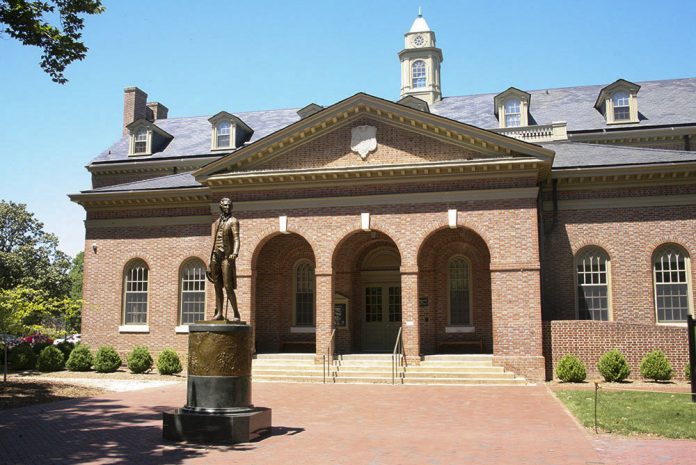Professor Elizabeth Otto, visited the College of William and Mary on to present a lecture titled “Designing Women of the Bauhaus” as a part of the Muscarelle Museum of Art’s Explorations series.
Specializing in the Bauhaus and gender in modern art, Otto is an Associate Professor of Art History and Visual Studies and the Alisa Mellon Bruce Senior Fellow at the University of Buffalo College of Arts and Sciences. She has published extensively on the Bauhaus, including her latest book, “Haunted Bauhaus,” which explores gender fluidity and radical politics of the Bauhaus.
This presentation comes at the centennial celebration of the existence of the Bauhaus—one of the most prominent and enduring art institutions to ever exist. Established in 1919, the Bauhaus grew to the scale of a movement, yet remained defined by the iconic institution that cultivated this movement. It was divided into many workshops of expertise, all of which emphasized functional and sleek design. After it shut its doors in 1933 due to mounting Nazi pressure, its artists dispersed across the globe to usher in a new era of modernity.
Though the Bauhaus has become a household name, there exist many stories from within it that remain untold. This is true for many of the women who studied there. Thirty-seven percent of Bauhaus artists were women, and they were represented in every single program the institution offered. The stories of many of these women — from Ré Soupault to Marianne Brandt — have been written out of history.
Otto structured the lecture to reflect the stories of four notable women of the Bauhaus, exploring each of their stories as individuals with varying relationships to the institution itself. Otto encouraged the audience to think beyond the confines of recorded history.
“I think you’ll see just how deep and wide-ranging Bauhaus women’s experimentation was,” Otto said. “How it became powerful shorthand for modernity and modern femininity, and how the Bauhaus was used by female designers in unexpected places and to unanticipatable ends.”
“I think you’ll see just how deep and wide-ranging Bauhaus women’s experimentation was,” Otto said. “How it became powerful shorthand for modernity and modern femininity, and how the Bauhaus was used by female designers in unexpected places and to unanticipatable ends.”
Friedl Dicker, who originated in the book-binding workshop at the Bauhaus, allowed for the self-evolution of her art. She began creating intricate political collages that coincided with her struggle to escape the Nazis, who targeted her for her Jewish heritage. Dicker taught art to young children in the ghetto of Theresienstadt and died in Auschwitz in 1944.
“Her teaching was a way to get out of this darker place and to explore their dreams,” Otto said.
According to Otto, female artists were more daring and open to redefining what Bauhaus truly meant. Gertrud Arndt, an expert rug maker, passed an exam in weaving before vowing to never weave again. From that day, she began to explore the possibilities of being outside the Bauhaus — including a series of pictures of herself ironically covered in fabric.
“These pictures allowed her to explore her transition from being a part of the Bauhaus, which is very future oriented — it’s geared towards making new things, meeting modern society, dreaming the next big dream, trying to imagine a better utopian future — and instead creating useless objects of herself in series that don’t seem to be going anywhere.”
The experiences of female artists within the Bauhaus are still pertinent today. Vivian Rust ‘23 said that exploring the unwritten history of these women is the process of realizing of their art and contribution to the movement.
“It’s a really good opportunity because it’s the stuff you don’t see in textbooks and its been overlooked for centuries so you’re developing deeper,” Rust said. “Realizing that you find art that is just as credible and just as wonderful that you didn’t know about before.”
Merritt Steadman ‘23 said that the movement pushed boundaries when it was challenged by prejudice and sexism in the greater societal context it existed in.
“These women need to be honored for their contributions to society that have not been recognized, as they are a source of inspiration for us today,” Steadman said. “By reflecting on past discrimination, we can move forward towards equality.”
“These women need to be honored for their contributions to society that have not been recognized, as they are a source of inspiration for us today,” Steadman said. “By reflecting on past discrimination, we can move forward towards equality.”
The Bauhaus was a representation of societal gender issues and was not immune to sexism on the individual and institutional level. When asked about whether this trend still exists in contemporary art, Otto noted the persistent issue of underrepresentation of the female artists.
“It is still taken as completely normal to do a historical or even a contemporary exhibition uniquely of male artists, and I just think that’s wrong,” Otto said. “As historians, as curators, as people telling these stories, we have to look broadly. It’s still going on.”

